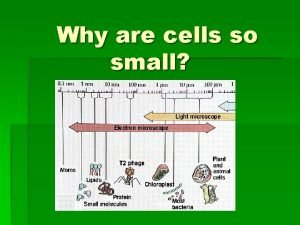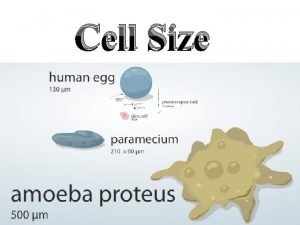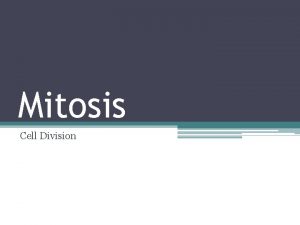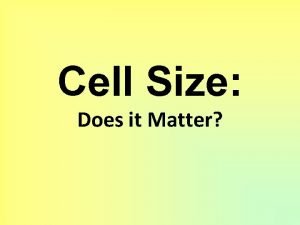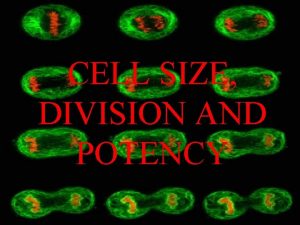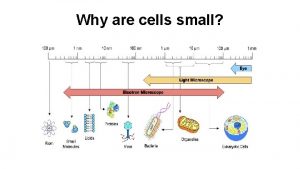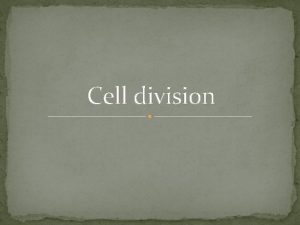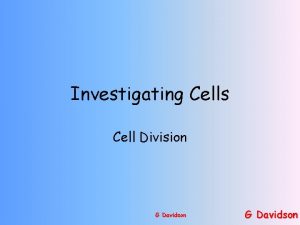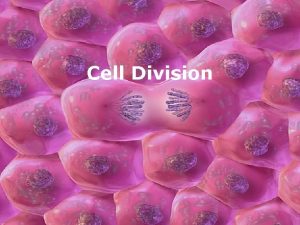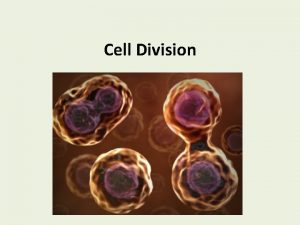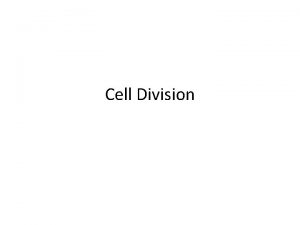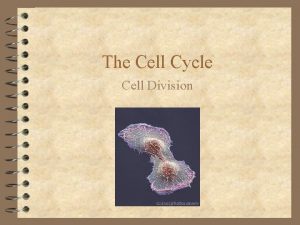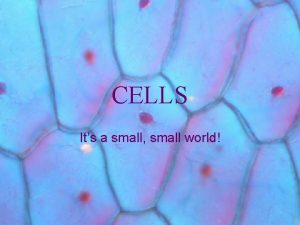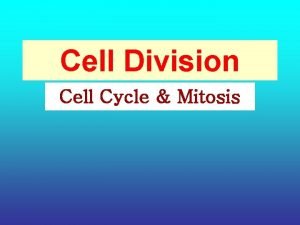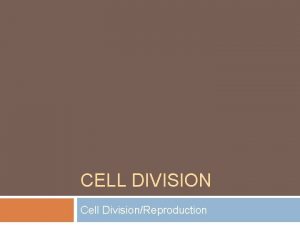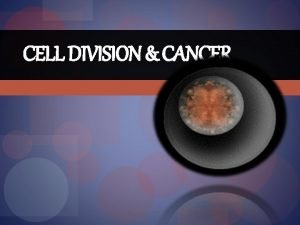CELL DIVISION CELL SIZE Why cells are small





























- Slides: 29

CELL DIVISION

CELL SIZE • Why cells are small – Surface area must be greater than volume. – Why? To take in sufficient nutrients and oxygen to maintain life.

PURPOSE OF CELL DIVISION – 1. Growth- increase in size – 2. Repair – needed because of worn out or injured cells. Your skin cells are replaced every 28 days – 3. Reproduction (2 types) • Asexual – one parent. Offspring identical to parent • Sexual – combination of genetic material from two parents

Asexual Reproduction 1. Where do the genes come from? • Single parent passes copies of all its genes to each of its offspring. There is no fusion of haploid cells 2. What is a clone? Organism that is genetically identical to its parent.

Types 1. 2. 3. 4. Asexual Reproduction Binary Fission – Fragmentation – Budding – Regeneration -

Asexual Types 1. Binary Fission-- separation of a parent into 2 or more individuals, ex. bacteria 2. Fragmentation-- body breaks into several pieces, ex. worms 3. Budding-- new individuals split off from existing ones. Bud make break off or remain attached to parent, ex. jellyfish, corals 4. Regeneration– renewal/regrowth of a lost part, ex. starfish, planaria

Asexual Reproduction Benefits/advantages – Produce many offspring in short period of time without using energy to produce gametes or to find a mate. Disadvantages – DNA varies little between organisms, which may make organisms not be able to adapt to a changing environment

Sexual Reproduction 1. Evolution – May have begun as a mechanism to repair damaged DNA. (Many modern protists are haploid most of the time, and they reproduce asexually. They form a diploid cell only in response to stress in the environment. Thus the process of meiosis and the pairing of homolgous chromosomes may have allowed early protistan cellls to repair damaged DNA. ) **More discussion to come in Meiosis Notes at a later date.

IMPORTANT TERMS • Chromatin – Strands of DNA that make up chromosomes.

TERMS, CONT. • Chromatids—one of the two strands of a chromosome that become visible during mitosis or meiosis • Centromere—the region of the chromosome that holds the two sister chromatids together

TERMS, CONT. • MITOSIS – Process of nuclear division • CYTOKINESIS-Process of division of the cytoplasm

The Cell Cycle • The cell cycle is a continuous process of an ordered set of events, of cell growth and division into two daughter cells, then the process starts again. When the cell cycle becomes out of control resulting in uncontrolled cell growth known as cancer. 2 Phases: I. Growth & preparation • Interphase II. Cell division • Mitosis – division of the nucleus • Cytokinesis – division of the cytoplasm

Cell Cycle

STAGES OF CELL CYCLE I. Growth & Preparation (Must occur before mitosis) INTERPHASE- getting ready stage (happens before mitosis, can often see nucleolus, DNA threadlike chromatin)

INTERPHASE cont. • 90% of cell’s time is spent in this phase • This is where the cell does most of its growth • Performs operations unique to the cells

INTERPHASE cont. • 3 stages: – G 1 – Growth & development – S- Chromosomes replicate (DNA replication) – G 2 - Organelles synthesized G stands for “Gap”; S stands for “Synthesis”

INTERPHASE cont • GAP “GROWTH” 1 STAGE – G 1 – Decides whether or not the cell will divide – Makes its structural proteins and enzymes to perform its functions • A pancreas cell will produce and secrete insulin • Salivary gland will produce and secrete enzymes in the mouth to aid in digestion – Each chromosome is a single molecule of DNA and associated proteins

INTERPHASE cont. • S Synthesis phase – DNA will copy itself within the nucleus – Each chromosome is copied – By end of phase there are two DNA molecules

INTERPHASE cont. • GAP “GROWTH” 2 PHASE – G 2 – DNA replication is checked by DNA repair enzymes – Cell prepares for mitosis – Proteins organize themselves to form a series of fibers called the spindles and centriole (involved in chromosome movement during mitosis)

4 Stages 1. Prophase 2. Metaphase 3. Anaphase 4. Telophase “P-MAT” MITOSIS

MITOSIS • PROPHASE – Condensing of 2 chromatids to form chromosomes hinged by a centromere • Coil up • Become visible – Centrioles begin to migrate to opposite sides of the cell – Nuclear envelope dissolves/disappears

MITOSIS • METAPHASE – Spindle fibers align the chromosomes along the middle of the cell. • This line is referred to as the metaphase plate. – This organization helps to ensure that in the next phase, when the chromosomes are separated, each new nucleus will receive one copy of each chromosome

MITOSIS • ANAPHASE – Chromatids move apart from one another – Each chromosome is attached to a spindle which moves them to opposite sides – Chromosomes can be seen moving – Results of equal separation and distribution of chromosomes

MITOSIS • TELOPHASE – Chromatids arrive at opposite poles of cell – New membranes form around the daughter nuclei. – The chromosomes disperse and spindle fibers disperse, and cytokinesis or the partitioning of the cell may also begin during this stage. – This phase is the reverse of Prophase

PROPHASE ANAPHASE METAPHASE TELOPHASE

MITOSIS—Summary PROPHASE- chromosomes evident, nuclear membrane disappearing (remember P for Phat —chromosomes fatten & are visible) METAPHASE- sister chromatids lined up in the middle/equator (M for middle, chromosomes lined up in the middle of cell)

ANAPHASE- sister chromatids pulled apart (A for Apart or Away because the chromatids pull apart and move away from center) TELOPHASE- chromosomes are at ends of cell, cells prepare to separate (T for Two new nuclear envelopes are forming) Cleavage furrow

• Cytokinesis After Mitosis… – Process of division of cytoplasm resulting in two identical cells • In animal cells, cell membrane pinches in (cleavage furrow) to make 2 new cells • In plant cells, a new cell wall forms along the cell plate between the 2 new cells

Websites • Cell Mitosis Lab Practice http: //www. biology. arizona. edu/cell_bio/activities/cell_cyc le/activity_description. html • Mitosis pictures & Video http: //www. iknow. net/CDROMs/cell_cdrom/cell 3. ht ml#mitosis • Cell Cycle Interactive Game http: //nobelprize. org/medicine/educational/2001/c ellcycle. html
 Antigentest åre
Antigentest åre Why did robert hooke name cells “cells”?
Why did robert hooke name cells “cells”? Why are cells small
Why are cells small How small are cells
How small are cells Hey hey bye bye
Hey hey bye bye Why is cell division important
Why is cell division important Cell surface area definition
Cell surface area definition Why does cell size matter
Why does cell size matter Cell cycle and cell division
Cell cycle and cell division Cell cycle and cell division
Cell cycle and cell division Steps of cell cycle
Steps of cell cycle Waters view
Waters view Loop of henle
Loop of henle Thyroid parafollicular cells
Thyroid parafollicular cells Gametes vs somatic cells
Gametes vs somatic cells Why dna is more stable than rna
Why dna is more stable than rna Red blood cells and white blood cells difference
Red blood cells and white blood cells difference Ghonarea
Ghonarea Similarities between plant and animal cells venn diagram
Similarities between plant and animal cells venn diagram Prokaryotic cell
Prokaryotic cell Masses of cells form and steal nutrients from healthy cells
Masses of cells form and steal nutrients from healthy cells Younger cells cuboidal older cells flattened
Younger cells cuboidal older cells flattened What cell type
What cell type Prokaryotic cell wall
Prokaryotic cell wall Nondisjunction in meiosis
Nondisjunction in meiosis Cell substance
Cell substance Dont ask
Dont ask Size of wbc cells
Size of wbc cells Short division vs long division
Short division vs long division Aynthetic division
Aynthetic division


